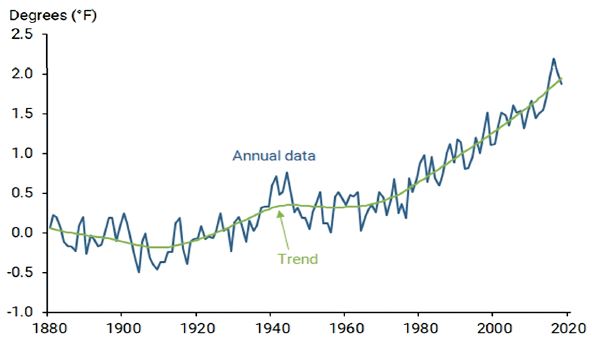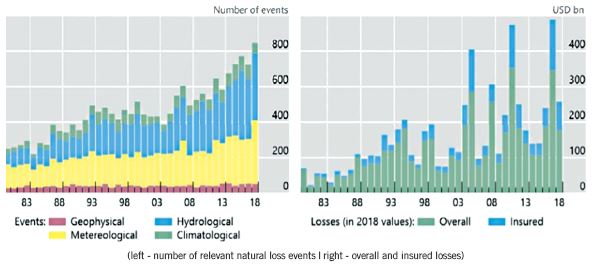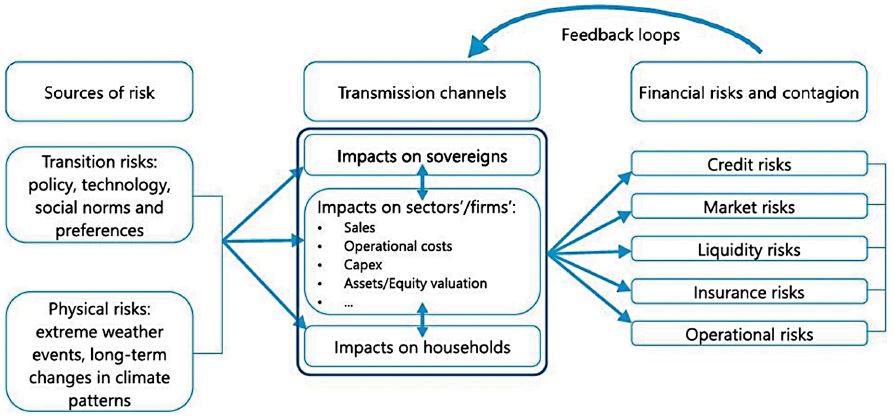Otaviano Canuto on Central Banks and Climate Change: Turning Black Swans Into Green
There are three possible motivations for the engagement by central banks with climate change: financial risks, macro-economic impacts, and mitigation/adaptation policies.
Regardless of the extent to which individual central banks incorporate the three prongs of motivations, they can no longer ignore the issue.
Last month, a Bank for International Settlements (BIS) book referred to a “green swan” as an adaptation of the concept of a “black swan” used in finance.

Chart 1: Change in global average temperature relative to 1880–1900.
Source: Rudebusch, G.D. Climate Change and the Federal Reserve, FRBSF Economic Letter 2019-09, March 25, 2019.
Note: Global average surface temperature based on land and ocean data from the National Aeronautics and Space Administration (NASA)
Extreme weather events — floods, violent storms, droughts and forest fires — occurred on all inhabited continents last year. At least seven of them resulted in damage of more than $10 billion, according to a report by Christian Aid.
Regardless of scepticism in some quarters, and the varying opinions about the role of human action, the fact is that the average global temperature at sea and on land has been rising since the 1970s, and shows a greater range of variations and extremes (Chart 1).
As a result of this rise in temperatures, there is a higher frequency of extreme weather events. A recently published study by Vinod Thomas and Ramón Lopez estimates that high-intensity storms and floods could double over the next 13 years. Chart 2 depicts the worldwide increase in natural catastrophes, and proportions of insured losses, in recent decades.
With different degrees of urgency and coverage, central banks are now considering climate change issues as relevant to their functions. Without the participation of the US Federal Reserve, 50 central banks created the Network of Central Banks and Supervisors for Greening the Financial System (NGFS) in December 2017. This is a network for mutual consultation on environmental risk-management practices, and those associated with climate change. Christine Lagarde, president of the European Central Bank (ECB), has stated that climate change policies will be crucial to her mandate.

(left – number of relevant natural loss events | right – overall and insured losses)
Chart 2: Increase in the number of extreme weather events and their insurance (1980-2018).
Source: Bolton et al, The green swan – central banking and financial stability in the age of climate change, BIS, Jan. 2020
(data from MunichRe, The Natural Disasters of 2018 in Figures)
There are three possible motivations for the engagement by central banks. The first is the set of risks to financial stability potentially brought about by natural disasters. This is particularly the case for financial sectors such as banks and insurance companies.
According to the Institute of International Finance (IIF) report Sustainable Finance in Focus, Climate change: a Core Financial Stability Risk (June 6, 2019) more than $2.5tn of global financial assets in 2016 were subject to some kind of risk as a result of climate change. As the first NGFS report noted: “Climate-related risks… fall squarely within the mandates of central banks and supervisors to ensure the financial system is resilient.”
There are two types of financial risk in this context: physical threats to the value of assets resulting from climate shocks, and trends such as rising sea levels, rising temperatures, and melting polar ice caps. Such physical risks include potential direct losses, and indirect impact on global value chains and repair costs.
There are also financial risks arising from climate change mitigation strategies that may be implemented, called “transition risks”. The move to a low-carbon economy will change the allocation of resources, technologies in use, and the construction of infrastructure. The strategies adopted will have consequences on the value of company assets, from carbon taxes to options to accelerate the transition to renewable energy.
Chart 3 provides a snapshot of associated financial risks.

Chart 3: Channels and spillovers for materialisation of physical and transition. Source: Bolton et al, The green swan – central banking and financial stability in the age of climate change, BIS, Jan. 2020
It is worth noting that risks associated with climate change also bring opportunities. According to estimates of growth models indicated by the IIF, a transition to a low-carbon economy could eliminate climate damage equivalent to nearly two percent of the GDP of G20 countries by 2050.
The Organisation for Economic Co-operation and Development (OECD) suggests that what it calls a “decisive transition” could raise GDP, in the long run, by up to 2.8 percent in the G20 countries.
In addition to financial risks and stability, another concern is impact on economic growth, inflation and on monetary policy decisions. ECB president Christine Lagarde evaluates climate change impacts on the eurozone economy in the institution’s models and assessments.
The Federal Reserve officially considers climate change to be a “negligible macro-economic risk” in the medium term. Nonetheless, as acknowledged by Glenn D Rudebusch, from the Federal Reserve Bank of San Francisco: “In coming decades, climate change — and efforts to limit that change and adapt to it — will have increasingly important effects on the US economy.” Relevant considerations for the Federal Reserve in fulfilling its mandate for macroeconomic and financial stability, he says.
Lael Brainard, a member of the board of governors of the Federal Reserve System, added: “Climate risks are projected to have profound effects on the US economy and financial system. To fulfil our core responsibilities, it will be important for the Federal Reserve to study the implications of climate change … and to adapt our work accordingly.”
The third area of potential central bank engagement with the issue of climate change is less consensual. It is about using their balance sheets to favour its mitigation, giving special treatment to green bonds in its asset acquisition programmes. Despite opposition from members of the ECB — such as the president of the Bundesbank, the German central bank — Christine Lagarde has referred to a role of the ECB in supporting the EU’s economic strategy.
Regardless of the extent to which individual central banks incorporate the three prongs of motivation, they can no longer ignore the issue of climate change. As noted in the book The Green Swan: “The growing realisation that climate change is a source of financial (and price) instability: it is likely to generate physical risks related to climate damages, and transition risks related to potentially disordered mitigation strategies. Climate change therefore falls under the remit of central banks, regulators and supervisors who are responsible for monitoring and maintaining financial stability.”
The book refers to a “green swan” as an adaptation of the concept of “black swan”, popularised in finance after Nassim Taleb’s 2007 book. Black swans refer to unexpected events, with low probability but heavy impact, only after they happen. By their nature, they do not fit the analysis of normal and known conditions. “Climate change can lead to ‘green swan’ events and be the cause of the next systemic financial crisis”, note the authors of the book.
About the author
Otaviano Canuto is principal at the Center for Macroeconomics and Development, a senior fellow at the Policy Centre for the New South and a non-resident senior fellow at Brookings Institution. He is a former vice-president and a former executive director at the World Bank, a former executive director at the International Monetary Fund, and a former vice-president at the Inter-American Development Bank. Otaviano has been a regular columnist for CFI.co for the past seven years.
Follow him on Twitter: @ocanuto
You may have an interest in also reading…
Tanzania Could Create Many New Jobs by Harnessing its Rapid Urban Expansion
Tanzania could create large numbers of new, productive jobs for its people, especially young men and women, if policy makers
From Local Strength to Continental Success: BAWAG’s Steady Expansion in Europe
BAWAG Group has emerged as one of Europe’s most efficient and profitable banking institutions, founded on a clear ambition: to
Travis Kalanick: Uber or Bust
Whether you’re the old-fashioned type that likes to hail a cab by the roadside or rich enough to have your



















































































